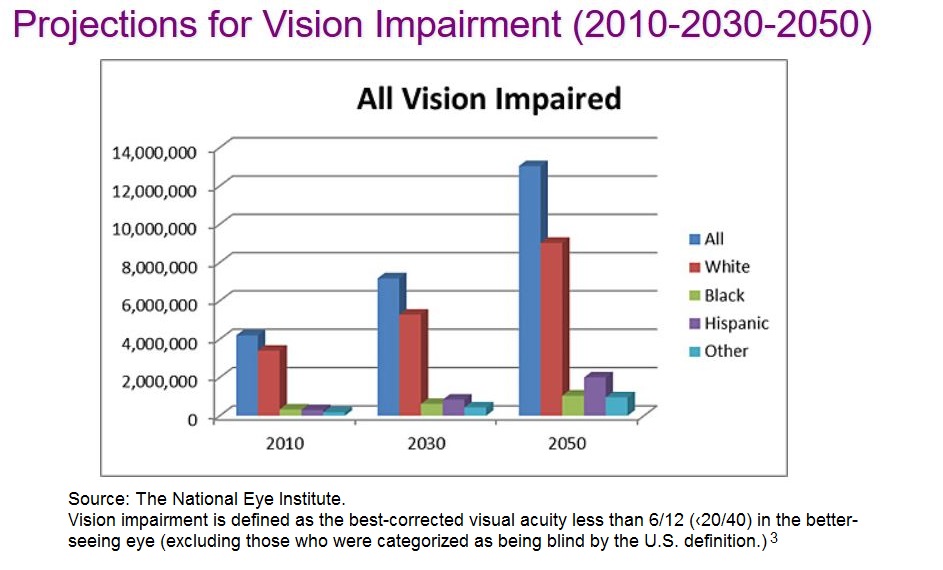Why private practice optometry will thrive in the digital age

The eye-care industry has always been a dynamic space. It’s a complex mix of private practitioners, HMO’s, government organizations, eye-wear vendors and corporate eye-care. The recent influx of online companies such as Warby Parker and Zeni Optical as well as new corporate retailers such as CVS has caused concern as to whether private practice optometry can survive in an environment that’s becoming increasingly corporate.
It’s Not a Zero-sum Game
It’s clear that the impact of corporations within eye-care will only grow in coming years, but does this mean that the number of patients served by private practice optometry will decline as a result? That would only be the case if a there was a fixed number of patients. The US population is growing however and with that growth comes a larger demand for eye-care services.6 The growth in demand is largely attributed to the increase of the incidence of myopia in the youth population and the increase of age related eye disease among the baby boomer generation.[6,7]
There has also been an a recent increase in patients with vision benefits due to the expansion of health insurance coverage and growth the the number of individuals who are eligible for medicare benefits. In fact, it’s estimated that by 2020 the number of individuals eligible for Medicare will grow by 10 million people.6 This will undoubtedly make a large impact on the industry as a whole considering 80% of patients seen by ODs today are covered by a managed vision care plan which accounts for 67% of OD revenue.[6] These factors combine to a projected 1-2% annual increase in the eye-care industry.[6]
Another opportunity for growth will come from making an effort to serve the sizeable portion of the population that does not receive routine eye-care today. For example, only half of the estimated 61 million adults in the United States classified as being at high risk for serious vision loss, visited an eye doctor in the past 12 months.5 There are also segments of the population such as children, persons with disabilities, and patients with unique vision needs (ie. athletes) that are currently under-served. For example, only 15% of preschool children in the US get an eye exam.[4] Online companies and corporate eye-care do not make it a priority to serve these populations, but private practice optometry can and should.

Optometry’s Advantage
Diversity is one of optometry’s great advantages. Two thirds of optometrists in the US work in a private practice setting, which means that there are effectively thousands of unique experiments being carried out to discover how to deliver the best patient care possible.[6] The diversity of approaches implemented by these private practices gives optometrists a large capacity to adapt to the needs of patients. In contrast, large companies have a limited ability to experiment with different approaches.
Optical vs. Medical Model
Some have suggested that the proper response to the emergence of online optical retailers is to move away from offering optical services in favor of focusing on delivering medical optometric services. The optical model and medical model both have their advantages and disadvantages. As a practitioner, you can see that both models involve dealing with factors outside of your control. On the optical side, optometrists compete with a variety of local and online vendors who offer eye-wear and contacts. They are also constrained by the terms available from the vendors whose products they carry in their practices.
On the medical side, optometrists incur a large amount of debt to acquire diagnostic equipment. They must also navigate the policies of insurance companies in order to receive reimbursement for their services. Most private optometric practices incorporate both models and as a result are able to offer a wide scope of services to patients. This enables continuity of care and better patient satisfaction. By doing this optometrists provide a service that no online provider can match.
Online vs. Brick and Mortar
The assumption that is often made that because some online companies are growing and more people are buying things online than ever before, brick and mortar retail must decline as a result. The fact of the matter is, people will continue to buy more and more online as long as there continues to be an advantage to it (convenience, price, etc.) and they will continue to shop at physical locations as long as there continues to be an advantage to that (good customer service, goodwill, personalized advice from experts, good feeling of supporting your local community, etc.).
Online players are realizing how valuable the advantages of physical locations are, which is why we are now seeing them move into physical retail to supplement their online businesses. (Think Amazon's recent acquisition of Whole Foods and the opening of many brick and mortar locations by Warby Parker). What does seem to be clear is that in order to maximize value, companies need to have both a physical and digital presence. Neglecting one or the other has become a luxury that businesses can’t afford.
Maintaining a Digital Presence
Having a digital presence in modern optometry essentially means engaging with your patients online. This is important - if optometrists want to build a strong relationship with their patients their interaction with patients can’t stop when the patient walks out the door. Optometrists need to have a plan in place for engaging with their patients throughout the year via channels like social media, web content, etc.
The purpose of this engagement is to communicate the purpose, identity, and values of your practice - who you are and why you do what you do. For example, if serving the community is core to your mission, then share the positive and engaging things you’re doing in the community. If valuing your patients and staff is central to the identity of your practice, share how you celebrate your patients and employees. Offering your patients a glimpse into how you embody your mission and values is a great way to endear patients to your practice and will help build familiarity, comfort, and trust. This is a great way to build value within your practice and compete with online companies without making concessions on what you charge for products and services.
The Showrooming Myth
Showrooming is the act of visiting a retail establishment to try on products first hand and later purchasing those products online where a cheaper price may be available. You’ve probably done this - find an item at a store and quickly check Amazon for a better price and free shipping.This is concerning to retailers for obvious reasons, but what you may not know is that the opposite (known as webrooming) is actually more likely to happen. According to a Harris poll only 46% of shoppers reported showrooming while 69% of reported webrooming.[1]
A poll by Merchant Warehouse found that shoppers prefer to webroom for the following reasons:[2]
- 47% did not want to pay shipping fees
- 23% did not want to wait for the product to be delivered
- 46% like to go to a store to touch and feel a product before they buy
- 37% like the option of being able to return an item to the actual store if needed
Doubling Down on Digital
Some doctors opt for a larger investment in the digital infrastructure of their practice that goes beyond patient engagement. Some of the options available in this area include offering online services through their practice website, such as the ability to order contacts or browse the practice’s frame selection digitally. These are worthwhile opportunities to explore once a practice has established a robust online presence.
The Future Success of Private Practice
We live in a time when patients have more information and choice than ever before when it comes to making decisions about their eye-care. In this context, the success of private practice optometry will come from the ability of optometrists to provide superior value to patients as opposed to online retailers who tend to mistake price for value and only focus on providing cheaper prices.
References
-
Adler, Emily. (2014, July 13) 'Reverse Showrooming': Bricks-And-Mortar Retailers Fight Back. Retrieved from http://www.businessinsider.com/reverse-showrooming-bricks-and-mortar-retailers-fight-back-2-2014-2
-
Stilson, Janet. (2014, May 9) Study Shows Prevalence of Consumer ‘Webrooming’. Retrieved from http://www.adweek.com/brand-marketing/zambezi-is-launching-a-new-division-to-help-brands-understand-female-consumers/
-
The National Eye Institute Statistics Data. Retrieved from https://nei.nih.gov/eyedata/vision_impaired
-
The Centers for Disease Control. Keep an Eye on Your Vision Health. Retrieved from https://webcache.googleusercontent.com/search?q=cache:yhYCKtv5VlUJ:https://www.cdc.gov/features/healthyvision/index.html+&cd=1&hl=en&ct=clnk&gl=us
-
Zhang X, Saaddine JB, Lee PP, et al. Eye care in the United States: do we deliver to high-risk people who can benefit most from it? Arch Ophthalmol 2007;125(3):411–418.
-
Harris Williams & Co. (2015, February) Vision Industry Overview. Retreived from http://www.harriswilliams.com/sites/default/files/content/hwco_hcls_vision_industry_updatev2.pdf
-
Howe, Neirl. (2015, November 30) The Eye Care Industry Focuses On Boomers -- And Millennials. Retreived from https://www.forbes.com/sites/neilhowe/2015/11/30/the-eye-care-industry-focuses-on-boomers-and-millennials/2/#1906932950fc
